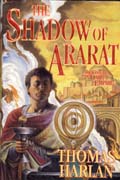 The
Shadow of Ararat
The
Shadow of Ararat
by Thomas Harlan
A book review by Mark L. Olson
Tor Fantasy, 1999, 510 pp, $26.95
If this book had been 10% shorter it would be one of the best fantasies I've read. As it is, it's one of the best SF books I've read this year and will probably be on my Hugo list.
The Shadow of Ararat takes place around 600 AD in an alternate world where a thousand years earlier magic was harnessed. So the world is different: There is no Christianity, and while there is a Judaism with a Torah, it's a dualistic religion. (Though the world is not different enough. Recognizable historical figures exist up until around 400 AD. It's as if Harlan had magic kick in at 400 BC, but history really didn't change much until 800 years later. Ridiculous, of course, but it does make for a much better story!)
Besides the intrusion of magic into the world, the second great change was that in this world around 400 AD, the Western Roman Empire beat back the barbarians and the Western and Eastern Empires are both alive and thriving. In fact, at the time of the story, the Western empire is a lot healthier than the Eastern.
There are five threads to the story which interweave throughout and will doubtless be followed on into the sequel(s).
(1) The Western Emperor is setting out to join the Eastern Emperor in a great expedition to end the Persian menace once and for all. The Western Emperor, Galen, is a decent sort. The Eastern Emperor, Heraclius, is the usual twisted Byzantine.
(2) Thyastis is a top female agent of the Western Emperor. He sends her on some of the most dangerous missions possible and she's always successful.
(3) Drwyinn MacDonald is a young Celt who is training in magic at a school in Egypt. He's a troublemaker, so when the Empire demands magicians to accompany the army into Persia, he's hastily commissioned as a Journeyman and sent into battle.
(4) Ahmet is Drwyinn's teacher and a powerful magician, who feels that Drywinn was badly treated. He follows Drywinn to try to help him, but gets sucked into a side theater of the war and falls in with one Mohammed, a merchant from Arabia, and the armies of the independent buffer state of Palmyra.
(5) Finally, Maxian, the younger brother of the Emperor Galen, who has been trained as a healer-magician-priest rather than in government, while poking around in some minor mysterious occurrences, discovers a terrible curse on all of Rome and builds up an enormous amount of magical power to try to stop it.
By the end of the book, the main plot's been resolved, but it's obvious that some of the 'minor' characters are actually going to figure in even bigger things later. The plot is intricate, but it works. My initial crack about it being 10% too long is because it drags a bit in places.
In spite of that, this is an excellent historical fantasy, being the other pole to Judith Tarr's excellent Lord of the Two Lands. In Tarr's book, the magical element is so light that you're never absolutely sure it's there. Here there's no doubt whatsoever. But both are well-told stories, well-grounded in their times.
Highly recommended.
NESFA homepage | Review Index | More Reviews by Mark L. Olson
